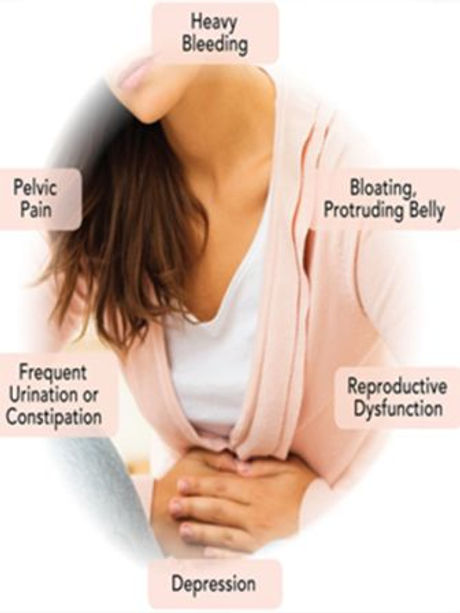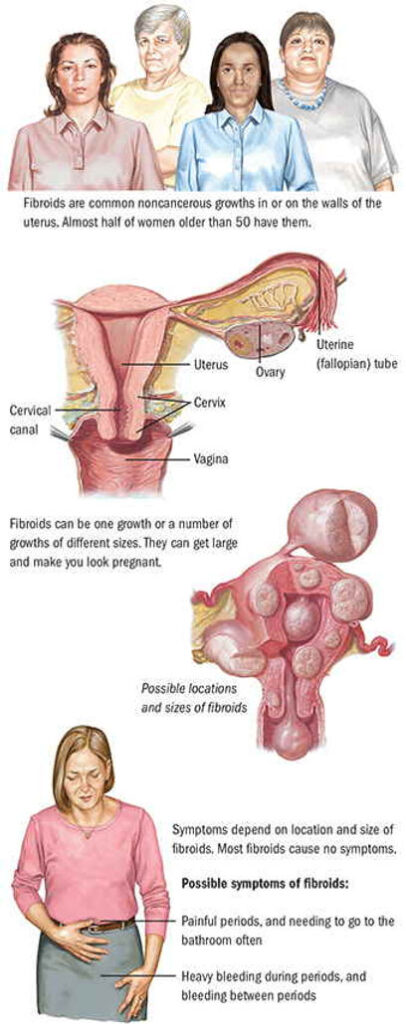आयुष्मान कार्ड के द्वारा आपरेशन इत्यादि एवं डायलिसिसि की सुविधा उपलब्ध है।
Fibroids
One of the most habitual conditions affecting the middle-aged women is Uterine Fibroids. Medically, it’s being termed as leiomyomas, leiomyomas is nothing, but the benign growths which may originate in the muscle of the uterus.
The average size of a fibroid may range from less than an inch mass to a melon sized mass. Sizes would get vary for different fibroids.
Uterine fibroids induce an adverse effect on the quality of women’s life. A considerable large-sized fibroid swell the uterus to a size of 18 weeks pregnancy. Apart from this, the fibroids flatten the bowel or the bladder leading to constipation or frequent urination.
Minimally invasive procedures :Uterine artery embolization : The procedure entails injection of certain medications which obstructs the blood flow to the fibroids, by allowing them to shrink.
Myolysis : The procedure has been carried out using laparoscope. Throughout this procedure, high-energy electric currents are being passed to harm the fibroids.
Laparoscopic myomectomy : The procedure entails excision of fibroids using a laparoscope. During the course of this procedure, the fibroids are being fragmented into small pieces and then removed.
Some of the other procedures are hysteroscopic myomectomy and endometrial ablation.


Some of the factors which enhance the risk of developing uterine fibroids
● Being a woman of reproductive age
● Aching abdomenFamily history of uterine fibroids
● Onset of menstruation at an early age
● High red meat consumption and lower consumption in green leafy vegetables
● Vitamin D deficiencies
● Alcohol consumption
● Obesity
● Birth control pills usage
The symptoms are getting occurred depending on the location, size, and number of fibroids.
The following are some symptoms list of uterine fibroids.
● Profuse menstrual bleeding
● Increased urination
● Menstruation lasting more than a week
● Difficulty in emptying the bladder
● Constipation
● Abdomen swelling
● Increased menstrual cramping
● Backache or leg pains
The accurate cause of uterine fibroids still remains unclear. But the below factors remain as the reason behind the uterine fibroids.
● Genetic mutations : In majority of the cases, fibroids are getting originated owing to the result of genetic alterations in the healthy uterine muscle cells.
● Hormonal changes : hormones, estrogen and progesterone, induces the regeneration of uterine lining during every menstrual cycle. These hormones prompt the growth of fibroids in the uterus.
● Other causes : Factors which help to sustain normal body mechanisms such as insulin-like growth would also induce uterine fibroids.
● Abnormal hormone levels : In the pregnancy period, there would be a constant increase in the levels of estrogen and progesterone. This paves the way for developing fibroids in the pregnant women, which would be getting shrunk off completely post pregnancy.
In majority of the cases, uterine fibroid remains untapped and unnoticed. Inadvertently, during a routine check-up, if doctors suspect uterine fibroids, then any of the following tests might be performed to confirm the diagnosis. Ultrasound of the pelvis. Imaging tests. Blood tests.
Uterine fibroids may not lead to life-menacing complications; however, it may cause utter discomfort. The presence of fibroids in the uterus may induce heavy blood loss during menstruation, and this may pave the way for the iron deficiency anemia. In pregnant women, uterine fibroids may enhance the risk of placental abruption, preterm delivery, and inadequate development of the fetus.
The treatment for uterine fibroids varies according to one’s age, the size of the fibroid, and magnanimity of the condition. Your doctor might order a combination of following treatments. Drugs: medications are used to subdue the symptoms such as discomfort, pelvic pain, and massive blood loss (menstrual cycle). Doctors might prescribe drugs which lessen the fibroids. Some of the drugs are :
● Gonadotropin-releasing hormone (Gn-RH) agonists- that helps in blocking the production of estrogen and progesterone.
● Progestin-releasing intrauterine device (IUD) that releases heavy blood loss due to menstruation.
● Other anti-inflammatory drugs (NSAIDs), and vitamin supplements.